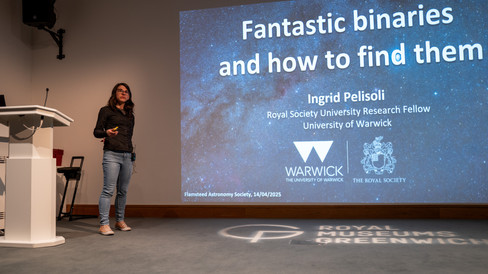Fantastic Binaries and How to Find Them, by Dr Ingrid Pelisoli
- Paul May

- Apr 15
- 2 min read
Thank you Ingrid for a spellbounding talk full of technical wizardry, and presented with great enthusiasm. Please see the full video here (password provided in weekly newsletter to members): https://player.vimeo.com/video/1075807850
Prior to the main lecture we had a fascinating short member talk from Yvonne who related her personal ambition to see the aurora which included several trips to Tronso in Norway. Essentially the message was, expect the unexpected, and be prepared, especially by having the appropriate equipment on hand at a moments notice!

Magical effects
Binaries are very common especially among blue giants where over 80% of stars have a companion. Such systems have a complex range of dynamics due to the different life cycles of constituent stars interacting in potentially many different ways. The most dramatic ending arises from a white dwarf absorbing material from a closely orbiting red giant, until it reaches a point where catastrophic nuclear reactions occur and the star goes supernova.

Lifting the invisibility cloak
There are a range of techniques for uncovering binary system where simple astronomical observation fails. These include: the observation of brightness variations due to either occultation, local heating or tidal effects; radial velocity measurements through the Doppler shift of spectral lines; and satellite-based astrometry to detect an unexpected wobble in a stars path. The first technique of measuring brightness variations, potentially on a few hours timescale, is accessible to amateur astronomers who have consequently made many contributions to the field.
Looking into the crystal ball
Ingrid discussed a couple of her favourite binaries, both of which required significant detective work to uncover the underlying nature of the system from the data. In one system the rotational speed was significant enough to show relativistic Doppler effects and her team were able to predict a supernova event in 70 million years!

Rabbits out of the hat
With a final magical flourish Ingrid was able to predict the first 3 questions from the audience and in the correct order having previously prepared some additional slides! These covered more complex multibody star systems, exotic exoplanets orbiting binary stars and the changing dynamics of binary star formation as the universe has evolved.
The field has a very exciting future, and Ingrid mentioned in particular a future space-based gravitational wave detector which should be sensitive enough to pick up gravitational waves from a number of binary systems. Cue for a future follow-up talk I'm sure you'll agree!



























Commenti